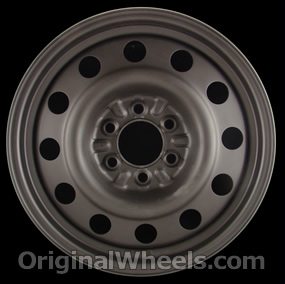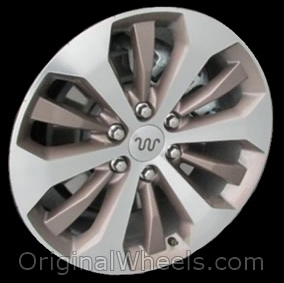The main and most obvious difference between the two different types of wheels is the material they are made of. A steel rim is just that, a rim made of steel. An alloy rim is made of a mixture of metal alloys, mainly aluminum, although there are some older wheels made of magnesium.
The Advantages of Steel Wheels
 Steel wheels have been around since the original Model T, so they’re not anything new. They are generally two pieces of steel, one sheet for the barrel part of the wheel, and one sheet for the face of the wheel. The barrel is welded into the circle and then the face is welded to the barrel. It’s very simple and efficient, the pieces can be stamped out cheaply and the welding (at least in these days) is all automated. This makes these wheels are very cheap to manufacture – and since they’re usually just painted a plain black or silver, the production cost is very low.
Steel wheels have been around since the original Model T, so they’re not anything new. They are generally two pieces of steel, one sheet for the barrel part of the wheel, and one sheet for the face of the wheel. The barrel is welded into the circle and then the face is welded to the barrel. It’s very simple and efficient, the pieces can be stamped out cheaply and the welding (at least in these days) is all automated. This makes these wheels are very cheap to manufacture – and since they’re usually just painted a plain black or silver, the production cost is very low.
Because of the low cost you usually find steel wheels on base model vehicles. They usually have a hubcap over the face of them to give them a bit more style and appeal but underneath the hubcap is just a plain steel wheel. Many people also use them for snow wheels, not because they are necessarily better in the winter than an alloy rim would be, but because they are cheaper to replace when they begin to rust and corrode from the salt on the roads, and there is no fear of damaging them with snow chains.
Overall the advantage to steel rims is just the cost. They are significantly cheaper than an alloy wheel.
Comparison Between The Two Types of Rims
Steel rims take damage differently than alloy wheels. If a steel wheel takes a severe impact it will normally bend. Depending on the severity of the bend, you can sometimes continue driving until you can get to a safe place to have it replaced. If an alloy wheel takes a severe impact, it will either bend or crack. The aluminum alloy is less flexible than the steel so there is a larger chance of actually cracking through the wheel. This would cause air to leak out quickly and could be very dangerous to drive on.
Advantages to Alloy Wheels
The biggest and most obvious advantage to alloy wheels is that they come in a wide variety of styles, sizes, and finishes. They don’t require a hubcap to make them look good, only the small center cap to complete the look. They come in everything from all painted silver, machined, polished, chrome, and everything in between.
The less obvious – but still very important – difference between the two styles is weight. Alloy wheels can be much larger and still weigh only a fraction of what a steel wheel would. This improves handling and gas mileage for a vehicle. Alloy wheels can also be made to a greater precision than steel wheels, which allows for better mounting and a smoother ride.
Choosing The Right Wheel For You
When deciding what kind of wheel you want for you car, you’ll have to decide what you’re planning on doing with it as well as your personal taste. Here at OriginalWheels.com we get people asking as all the time if they should go with a standard steel wheel or an aluminum alloy wheel.
If you live in an area that snows a lot it might be worth having a set of steel rims just for the winter. If you’re doing a lot of off-roading where the rims are going to be taking a beating, it might be worth getting steel wheels that would be cheaper to replace. If you’re a bit more thrifty in your spending and just have a car that can get you from point A to point B, a steel wheel for your Toyota Camry might be the right choice.
Alloy wheels, on the other hand, are for people that want their car to look good. They take pride in the vehicle they drive and want it to reflect that pride. If you want optimum performance and the smoothest ride possible, then alloy wheels are the right choice for you.


Alloy wheels are also better heat conductors than steel wheels, improving heat dissipation from the brakes, which reduces the chance of brake failure in more demanding driving conditions.